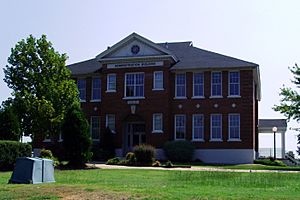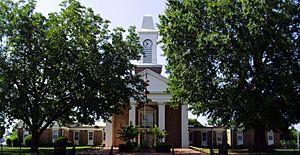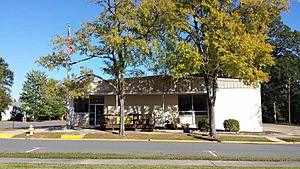Sheridan, Arkansas facts for kids
Quick facts for kids
Sheridan, Arkansas
|
|
|---|---|
| City of Sheridan | |
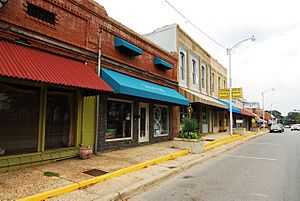
Downtown Sheridan
|
|
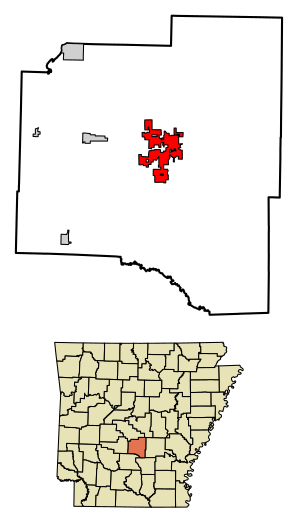
Location of Sheridan in Grant County, Arkansas.
|
|
| Country | |
| State | |
| County | Grant |
| Townships | Calvert, Merry Green |
| Incorporated | August 26, 1887 |
| Named for | Lieut. Gen. Philip Sheridan |
| Government | |
| • Type | Mayor-Council |
| Area | |
| • Total | 12.20 sq mi (31.59 km2) |
| • Land | 12.19 sq mi (31.58 km2) |
| • Water | 0.00 sq mi (0.01 km2) |
| Elevation | 276 ft (84 m) |
| Population
(2020)
|
|
| • Total | 4,920 |
| • Density | 403.48/sq mi (155.78/km2) |
| Time zone | UTC−6 (CST) |
| • Summer (DST) | UTC−5 (CDT) |
| ZIP code |
72150
|
| Area code(s) | 870 |
| FIPS code | 05-63710 |
| GNIS feature ID | 2405459 |
| Major airport | Clinton National (LIT) |
Sheridan is a city in Arkansas, United States. It is the main city of Grant County. You can find it deep in the forests of the Arkansas Timberlands. Two major roads, US Highways 167 and 270, meet there.
People first came to this area because of the many trees. Timber (wood) is still a very important part of Sheridan's economy. However, the city now has many other types of businesses too. Sheridan also had a college, Missionary Baptist College, which closed in 1934.
Sheridan is at the southern end of the Central Arkansas region. Its population has been growing a lot recently. Between 1990 and 2010, the number of people living there grew by 49%. In 2010, 4,603 people lived in Sheridan.
Contents
History of Sheridan
Early Days and Land Ownership
From 1818 to 1824, the land where Sheridan is today was a special area for the Quapaw Native American tribe. This was their reservation. Later, after a law called the Indian Removal Act of 1830 was passed, the Quapaw people had to move further west. By 1833, most Native Americans had left, and the land became part of the United States.
Who Was Sheridan Named After?
The community of Sheridan is named after Lieutenant-General Philip Sheridan. He was a very important military leader. He served as the 8th Commanding General of the United States Army from 1883 to 1888.
First Settlers and Early 1900s
The first white settler in the area was Dr. Richard C. Rhodes. He came from North Carolina.
At the start of the 1900s, a railroad line went through Sheridan. It traveled south into Dallas County. This railroad was owned by E. S. McCarty. It carried both goods and people.
A religious college, Missionary Baptist College, opened in Sheridan in 1917. It closed in 1934 because of money problems caused by the Great Depression. The college wanted to teach the beliefs of the Baptists in Arkansas. After it closed, a new school, Missionary Baptist Seminary, opened in Little Rock.
Mid-1900s Events
In 1943, a man named Jewell Williams, who was a Jehovah's Witness, was fined for selling Bibles without a permit. He believed this was unfair and went to court. The Arkansas Supreme Court agreed with him. They said that city rules like this were against the First Amendment of the U.S. Constitution, which protects freedom of speech and religion.
In 1973, a music festival called the Rebel Springs Rock Festival took place near Sheridan. It was about 5 miles east of the city. Famous bands like ZZ Top played there. Tickets cost $4, and the festival lasted for three days in July. The National Guard was there to help keep things peaceful.
In 1954, the school board in Sheridan decided to follow a Supreme Court ruling called Brown v. Board of Education. This ruling said that separate schools for different races were not fair. Sheridan had a school for Black children and sent its Black high school students to other counties. However, after strong protests, the school board changed its mind the very next night. This led to a difficult time for the Black community in Sheridan.
Geography and Weather
Sheridan's Climate
Sheridan has a climate with warm summers and mild winters. It gets a good amount of rain throughout the year. The hottest month is usually July, and the coldest is January.
| Climate data for Sheridan, Arkansas (1991–2020 normals, extremes 1977–present) | |||||||||||||
|---|---|---|---|---|---|---|---|---|---|---|---|---|---|
| Month | Jan | Feb | Mar | Apr | May | Jun | Jul | Aug | Sep | Oct | Nov | Dec | Year |
| Record high °F (°C) | 80 (27) |
86 (30) |
91 (33) |
96 (36) |
97 (36) |
104 (40) |
108 (42) |
107 (42) |
108 (42) |
97 (36) |
86 (30) |
79 (26) |
108 (42) |
| Mean maximum °F (°C) | 71.2 (21.8) |
75.4 (24.1) |
82.7 (28.2) |
87.3 (30.7) |
91.1 (32.8) |
95.5 (35.3) |
99.5 (37.5) |
100.0 (37.8) |
95.8 (35.4) |
89.4 (31.9) |
79.4 (26.3) |
72.8 (22.7) |
101.0 (38.3) |
| Mean daily maximum °F (°C) | 51.3 (10.7) |
56.5 (13.6) |
65.2 (18.4) |
74.1 (23.4) |
81.2 (27.3) |
88.4 (31.3) |
92.0 (33.3) |
91.5 (33.1) |
85.7 (29.8) |
75.0 (23.9) |
62.7 (17.1) |
53.5 (11.9) |
73.1 (22.8) |
| Daily mean °F (°C) | 40.2 (4.6) |
44.5 (6.9) |
52.3 (11.3) |
61.0 (16.1) |
69.6 (20.9) |
77.4 (25.2) |
81.0 (27.2) |
80.2 (26.8) |
73.6 (23.1) |
61.9 (16.6) |
50.5 (10.3) |
42.8 (6.0) |
61.2 (16.2) |
| Mean daily minimum °F (°C) | 29.2 (−1.6) |
32.5 (0.3) |
39.4 (4.1) |
47.8 (8.8) |
58.0 (14.4) |
66.5 (19.2) |
70.0 (21.1) |
68.8 (20.4) |
61.5 (16.4) |
48.8 (9.3) |
38.4 (3.6) |
32.1 (0.1) |
49.4 (9.7) |
| Mean minimum °F (°C) | 14.9 (−9.5) |
19.4 (−7.0) |
24.1 (−4.4) |
33.3 (0.7) |
44.5 (6.9) |
57.1 (13.9) |
63.3 (17.4) |
61.4 (16.3) |
47.9 (8.8) |
33.7 (0.9) |
23.7 (−4.6) |
19.1 (−7.2) |
13.1 (−10.5) |
| Record low °F (°C) | −3 (−19) |
0 (−18) |
13 (−11) |
26 (−3) |
34 (1) |
45 (7) |
55 (13) |
48 (9) |
37 (3) |
25 (−4) |
14 (−10) |
−8 (−22) |
−8 (−22) |
| Average precipitation inches (mm) | 4.05 (103) |
4.32 (110) |
5.61 (142) |
5.94 (151) |
5.71 (145) |
4.17 (106) |
4.30 (109) |
2.88 (73) |
3.57 (91) |
4.56 (116) |
4.61 (117) |
5.49 (139) |
55.21 (1,402) |
| Average snowfall inches (cm) | 1.2 (3.0) |
0.9 (2.3) |
0.4 (1.0) |
0.0 (0.0) |
0.0 (0.0) |
0.0 (0.0) |
0.0 (0.0) |
0.0 (0.0) |
0.0 (0.0) |
0.0 (0.0) |
0.0 (0.0) |
0.0 (0.0) |
2.5 (6.4) |
| Average precipitation days (≥ 0.01 in) | 7.6 | 7.4 | 8.4 | 7.5 | 8.0 | 6.6 | 6.9 | 5.2 | 5.1 | 6.0 | 6.8 | 7.3 | 82.8 |
| Average snowy days (≥ 0.1 in) | 0.4 | 0.5 | 0.1 | 0.0 | 0.0 | 0.0 | 0.0 | 0.0 | 0.0 | 0.0 | 0.1 | 0.1 | 1.2 |
| Source: NOAA | |||||||||||||
People of Sheridan
| Historical population | |||
|---|---|---|---|
| Census | Pop. | %± | |
| 1880 | 42 | — | |
| 1890 | 184 | 338.1% | |
| 1900 | 210 | 14.1% | |
| 1910 | 481 | 129.0% | |
| 1920 | 695 | 44.5% | |
| 1930 | 1,590 | 128.8% | |
| 1940 | 1,338 | −15.8% | |
| 1950 | 1,893 | 41.5% | |
| 1960 | 1,938 | 2.4% | |
| 1970 | 2,480 | 28.0% | |
| 1980 | 3,042 | 22.7% | |
| 1990 | 3,098 | 1.8% | |
| 2000 | 3,872 | 25.0% | |
| 2010 | 4,603 | 18.9% | |
| 2020 | 4,920 | 6.9% | |
| U.S. Decennial Census | |||
Sheridan is part of the larger Little Rock–North Little Rock–Conway metropolitan area. This means it's connected to a bigger group of cities.
What the 2020 Census Shows
| Race | Number | Percentage |
|---|---|---|
| White (non-Hispanic) | 4,323 | 87.87% |
| Black or African American (non-Hispanic) | 157 | 3.19% |
| Native American | 25 | 0.51% |
| Asian | 48 | 0.98% |
| Pacific Islander | 1 | 0.02% |
| Other/Mixed | 228 | 4.63% |
| Hispanic or Latino | 138 | 2.8% |
In 2020, the 2020 United States census counted 4,920 people living in Sheridan. There were 1,884 households and 1,235 families.
What the 2010 Census Shows
The 2010 United States census showed that 4,603 people lived in Sheridan. There were 1,841 households and 1,238 families. About 32.7% of households had children under 18. The average household had 2.46 people.
The median age in the city was 36.6 years old. This means half the people were younger and half were older. About 25.2% of the population was under 18. The city had slightly more females (50.4%) than males (49.6%).
The median income for a household was $57,305. This is the middle income for all households. About 8.1% of all people in Sheridan lived below the poverty line.
Education in Sheridan
Public education in Sheridan is provided by the Sheridan School District. This includes the Sheridan High School.
In the past, Sheridan had separate schools for African-American students. In 1954, the local school board first voted to allow all students to attend the same high school. However, due to strong community reactions, they changed their decision the next night. This led to a difficult period for the African-American community in Sheridan.
In March 2014, the principal of Sheridan High School, Rodney Williams, decided to remove a student's profile from the yearbook. This was because the student was openly gay. In response, a human rights group held a protest. The principal also received a petition with 30,000 signatures asking him to change his decision.
Fun Things to Do and See
Sheridan has an annual event called Timberfest. This festival celebrates the area's history with the timber industry. It includes a lumberjack competition and live music near the courthouse. A movie called The White River Kid, starring Antonio Banderas, was filmed during a mock Timberfest in 1998. Many local people were in the movie as extras.
Places to Visit
The Grant County Museum is in Sheridan. It helps people learn about the history and culture of the county. The museum has exhibits about the Battle of Jenkins' Ferry, a Civil War battle. It also has a large collection of World War II vehicles. You can learn about pioneer life and the plants and animals native to the county.
The Heritage Square is also at the museum. It has ten old buildings that were moved and fixed up. Just north of Sheridan, there is a memorial for nine airmen who died in a plane crash in 1943. A replica of a B-17 plane was built there to honor them.
News and Media
The first newspaper in the Grant County area was called The Sheridan Spy. It started on September 1, 1881. In 1882, J.S. Williams bought the paper and renamed it The Sheridan Headlight. This newspaper is still published today. Another short-lived newspaper, Grant County News, started in 1916.
City Services
Sheridan's water system began in the 1930s. The city later bought it. Now, the Sheridan Water and Sewer Department manages the system. Sheridan can treat water from five wells. It can treat 4.5 million gallons (17 million liters) of water each day. The city also has a facility that cleans wastewater before it goes into Big Creek.
Famous People from Sheridan
- Ken Bragg, a politician who represents Sheridan in the Arkansas House of Representatives.
- Buck Fausett, a former Major League Baseball player.
- David Delano Glover, a politician who represented Arkansas in the U.S. Congress.
- Ray Hamilton, a football player in the National Football League.
- John Little McClellan, a lawyer and politician who served as a representative and senator for Arkansas.
- Earl Smith, a baseball player for the Giants and Pirates.
- Eddie Joe Williams, a State Senate Majority Leader and former mayor of Cabot, Arkansas.
- Jami Cook, a police officer and the first Secretary of the Arkansas Department of Public Safety.
Images for kids
See also
 In Spanish: Sheridan (Arkansas) para niños
In Spanish: Sheridan (Arkansas) para niños



